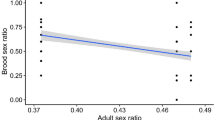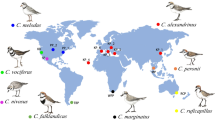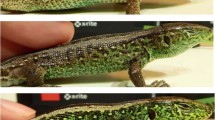Abstract
IN animals with parental care, parents rearing offspring of variable ages are typically assumed to exert less effort than those rearing even-aged offspring. This is because spaced births spread out peak loads in the combined food demands of all offspring1–3. Creating a mixed-size sibship also helps establish a hierarchy among the young which reduces the costs of sibling rivalry4 and can help efficient elimination of young if food becomes short5,6. We manipulated hatching spread within broods of the blue tit Parus caerulem and studied postbreeding survival rate of the adults. We report here that, contrary to current theory, female parents suffer less when the young are even-aged than when they are of variable ages, whereas the opposite result was found for male parents. Apparently, the male contributes more in synchronous broods, thus lightening the female's total investment burden. In blue tits this sexual conflict over hatching pattern is won by the female because she alone incubates. By delaying incubation until most eggs have been laid, she reduces hatching span.
This is a preview of subscription content, access via your institution
Access options
Subscribe to this journal
Receive 51 print issues and online access
$199.00 per year
only $3.90 per issue
Buy this article
- Purchase on Springer Link
- Instant access to full article PDF
Prices may be subject to local taxes which are calculated during checkout
Similar content being viewed by others
References
Hussell, D. J. T. Ecol. Monogr. 42, 317–364 (1972).
Blurton-Jones, N. Ethol. Sociobiol. 7, 91–105 (1986).
Thapa, S., Short, R. V. & Potts, M. Nature 335, 679–682 (1988).
Hamilton, W. D. J. theor. Biol. 7, 1–52 (1964).
Lack, D. Ibis 89, 302–352 (1947).
Magrath, R. D. Nature 339, 536–538 (1989).
Magrath, R. D. Biol. Rev. 65, 587–622 (1990).
Clark, A. B. & Wilson, D. S. Q. Rev. Biol. 56, 253–277 (1981).
Mock, D. W., Drummond, H. & Stinson, C. H. Am. Scient. 78, 438–449 (1990).
Dickemann, M. in Infanticide: Comparative and Evolutionary Perspectives (eds Hausfater, G. & Hrdy, S. B.) 427–437 (Aldine, New York, 1984).
Hahn, D. C. Anim. Behav. 29, 421–427 (1981).
Mock, D. W. & Ploger, B. J. Anim. Behav. 35, 150–160 (1987).
Slagsvold, T. & Lifjeld, J. T. Am. Nat. 134, 239–253 (1989).
Trivers, R. L. in Sexual Selection and the Descent of Man, 1871–1971 (ed. Campbell, B.) 136–179 (Aldine, Chicago, 1972).
Smith, J. N. M. & Merkt, J. R. Can. J. Zool. 58, 1869–1875 (1980).
Stamps, J., Clark, A., Arrowood, P. & Kus, B. Behaviour 94, 1–40 (1985).
Gottlander, K. Ornis Scand. 18, 269–276 (1987).
Sasvari, L. Ornis Scand. 21, 287–292 (1990).
Lifjeld, J. T., Breiehagen, T. & Lampe, H. M. Ornis Scand. 23, 199–201 (1992).
Birkhead, T. R. & Møller, A. P. Sperm Competition in Birds: Evolutionary Causes and Consequences (Academic, London, 1991).
Kempenaers, B. et al. Nature 357, 494–496 (1992).
Westneat, D. F. & Sherman, P. W. Behav. Ecol. 4, 66–77 (1993).
Breitwisch, R. Curr. Orn. 6, 1–50 (1989).
Perrins, C. M. British Tits (Collins, London, 1979).
Dhondt, A. A. Ibis 129, 327–334 (1987).
Nur, N. J. Anim. Ecol. 53, 497–517 (1984).
Magrath, R. D. J. Anim. Ecol. 60, 335–351 (1991).
Slagsvold, T. & Lifjeld, J. T. Ecology 71, 1258–1266 (1990).
Stresemann, E. & Stresemann, V. J. Orn. 107, 1–448 (1966).
Author information
Authors and Affiliations
Rights and permissions
About this article
Cite this article
Slagsvold, T., Amundsen, T. & Dale, S. Selection by sexual conflict for evenly spaced offspring in blue tits. Nature 370, 136–138 (1994). https://doi.org/10.1038/370136a0
Received:
Accepted:
Issue Date:
DOI: https://doi.org/10.1038/370136a0
This article is cited by
-
Hatching asynchrony as a parental reproductive strategy in birds: a review of causes and consequences
Journal of Ornithology (2023)
-
The effect of the ectoparasite Carnus hemapterus on immune defence, condition, and health of nestling European Bee-eaters
Journal of Ornithology (2018)
-
Hatching asynchrony vs. foraging efficiency: the response to food availability in specialist vs. generalist tit species
Scientific Reports (2016)
-
Patterns of brood division and an absence of behavioral plasticity in a neotropical passerine
Behavioral Ecology and Sociobiology (2008)
-
Sibling Growth Patterns in Great tits: Does Increased Selection on Last-hatched Chicks Favour an Asynchronous Hatching Strategy?
Evolutionary Ecology (2006)
Comments
By submitting a comment you agree to abide by our Terms and Community Guidelines. If you find something abusive or that does not comply with our terms or guidelines please flag it as inappropriate.



